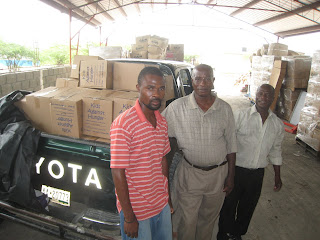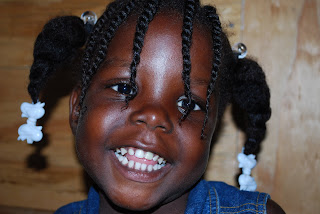
Mark Julian arrived at the GAiN Warehouse in Chambrun, Haiti, on May 27. Pastor Esperondu Pierre (the Campus Crusade director in Haiti) offered Julian’s ministry (SMI Haiti) the one thing he needed more than anything—food.
“We are getting 5 pallets of food today. That will last about two weeks. Maybe 3 weeks,” Julian said.
SMI Haiti’s goal is to support the needs of the orphanage of 70 children in the Gitonn area—a very impoverished area.
“We need all kinds of food all the time with 70 kids,” Julian said. “We also have a school. We had to cut back from 1,600 students to 500 students because part of the school program is to feed them 3 meals a week. We have not been able to feed 1,600 kids 3 times a week, so we have pared that back to 500 so that we can supply the three meals a week. It is so vital for learning to have full stomachs. Sometimes the kids would just sit there and pass out or fall asleep because they do not have food. So we have a lot of need for food. We have wells, we have water available. Food is the critical element.”
Rice is one of the main food elements of the Haitian people. But the second food staple is beans. Several ministries have asked GAiN to provide not only rice, but the familiar protein element of beans as well.
A Lancaster County church has heard the call for help coming from Haiti. They raised the funds to help purchase 360,000 additional meals of rice and beans. Many of these have been packed already, but we still need help to finish up the packing of this desperately needed food, as well as pack more that we have available. Thus, we have added an additional 200,000 meals of rice and beans and an additional 30,000 meals from Feed My Starving Children.
During the June Mission packing Project at the GAiN Distribution Center, we will finish up packing the high protein rice and bean meals June 21 and 22. Then we will continue the rest of the week packing the 180,000 Feed My Starving Children rice and soy meals.
Pastor Jorel Naurelus of the Church of God in Christ in Haiti also received food from GAiN last week.
Pastor Jorel said: "After the earthquake, I came here to talk to Pastor Pierre. He gave me some food and I shared it with my people. They were so happy, but I did not have enough to give because I have so many people! So I talked to Pastor Pierre again and he said come again and we will give you more food. I have a lot of families under the tent now.
"The government has stopped giving food to the people. My people are very hungry—they are starving. So we need your support. We thank you for what you have been doing. We keep praying for you so the Lord can open more doors. We pray that the Lord blesses you and that we would be blessed by you."



















